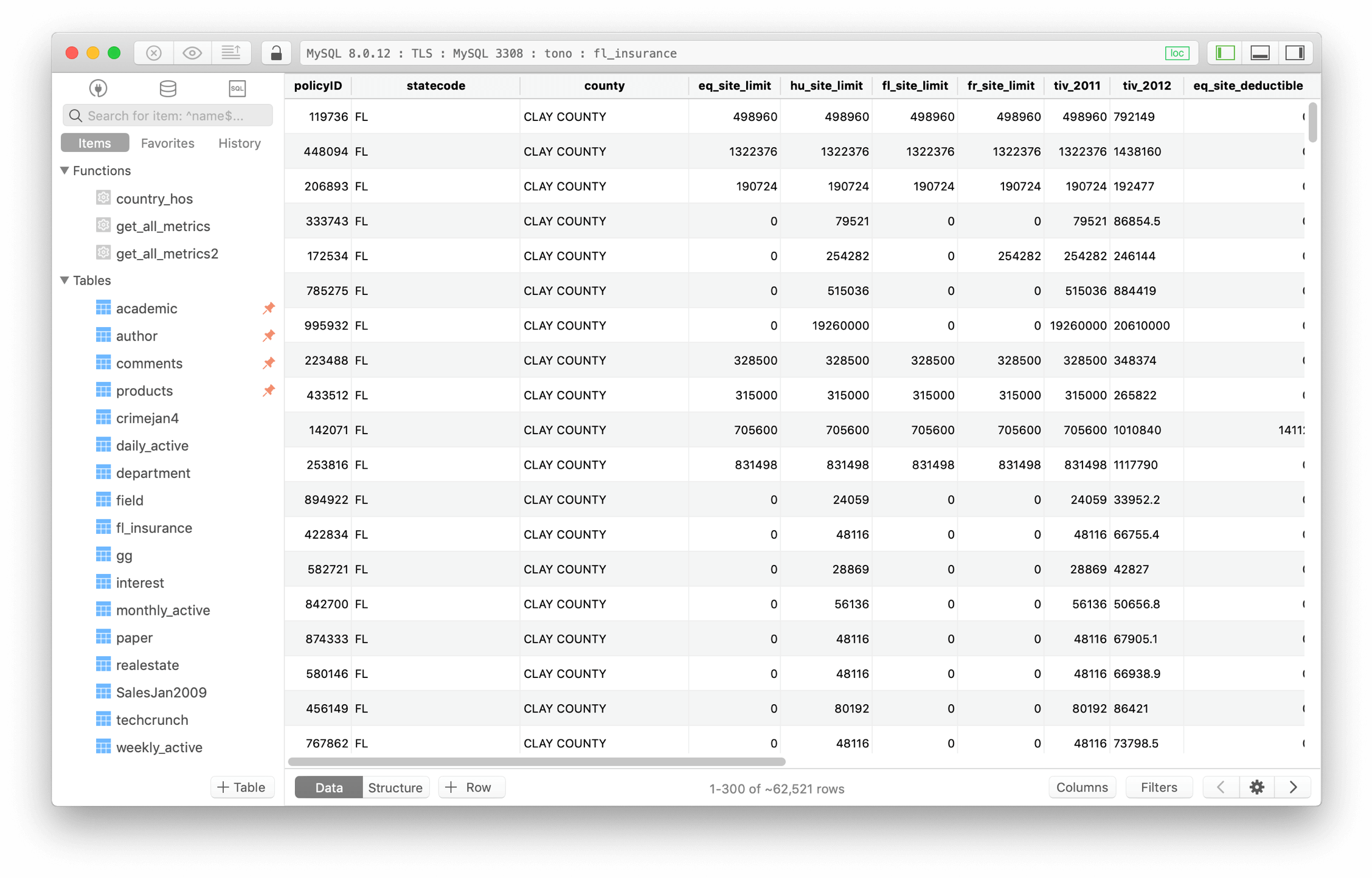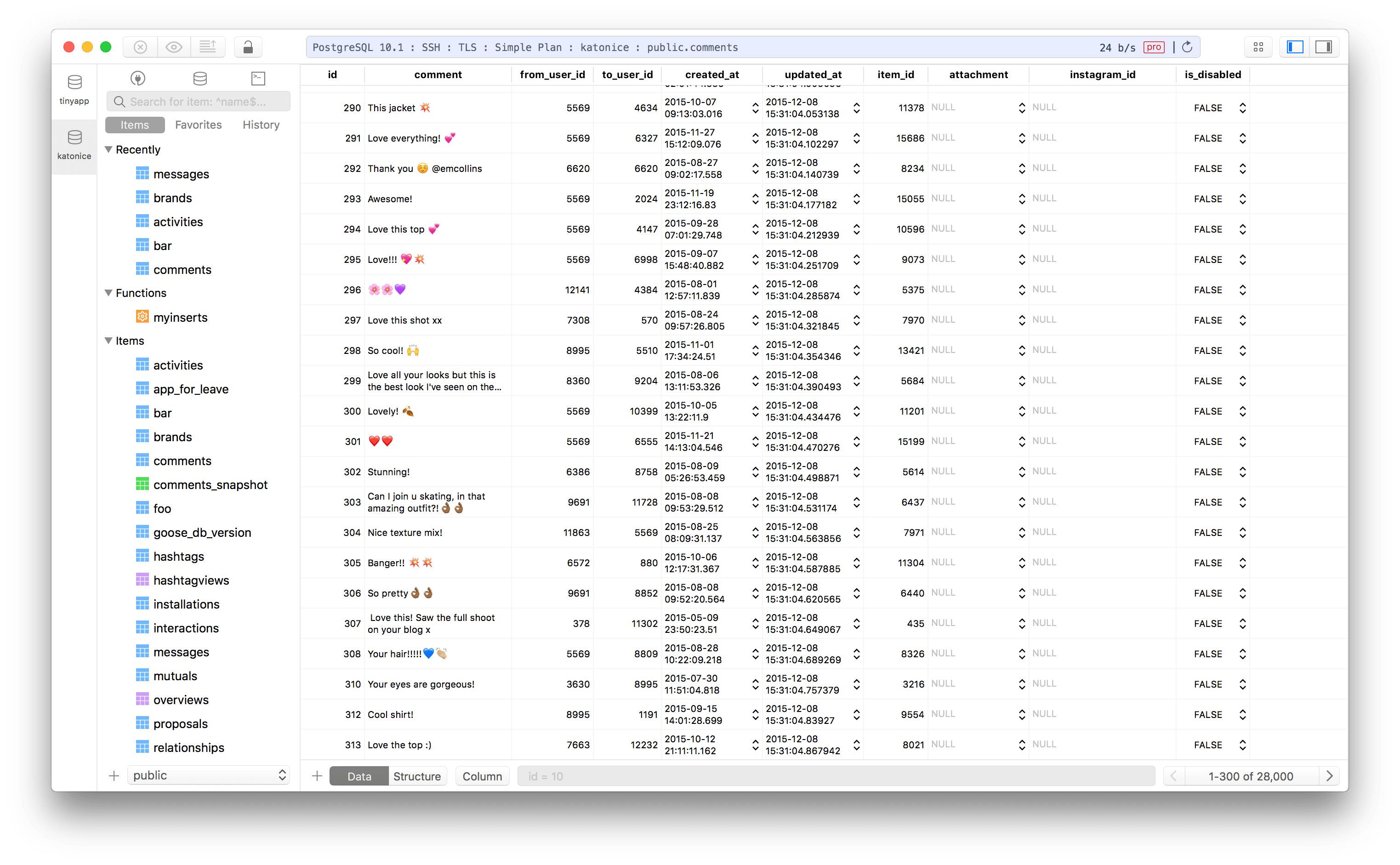Related articles:
We splashed out £140 (around $200, AU$290) on a Linx 1010 Windows 10 tablet with add-on keyboard – it's powered by a quad-core Atom Z3735F processor, 2GB RAM, and has a 1280 x 800 10.1-inch. All tablets come with an operating system, no mater who produces it. Some of these systems include Ubuntu, Backtrack, and Debian. These are all distributions of Linux that work on tablets. What brands of tablet have a Linux operating system? A major brand that uses the Linux operating system is Amazon for its Kindle e-book line. A native GUI tool for MySQL, PostgreSQL, SQL Server & more. TablePlus is a modern, native, and friendly GUI tool for relational database, it makes database management easy. Azure Table storage is a service that stores structured NoSQL data in the cloud, providing a key/attribute store with a schemaless design. Because Table storage is schemaless, it's easy to adapt your data as the needs of your application evolve.
Install Tableplus Linux
Linux can seem like a very daunting environment. But it doesn't have to be! With the two topics in this cheat sheet—the commands you'll use on a daily basis and the useful help pages—you can easily navigate your Linux environment. Firefox 72 issue.
Linux Commands
Sqlpro studio 1 0 411 free. Although you can do most things in Linux these days by pointing and clicking, you still may want to try using Linux at the command prompt. This table shows you the commands that help you navigate your Linux system using only your keyboard.
| Command | Description |
| cat [filename] | Display file's contents to the standard output device (usually your monitor). |
| cd /directorypath | Change to directory. |
| chmod [options] modefilename | Change a file's permissions. |
| chown [options] filename | Change who owns a file. |
| clear | Clear a command line screen/window for a fresh start. |
| cp [options] sourcedestination | Copy files and directories. |
| date [options] | Display or set the system date and time. |
| df [options] | Display used and available disk space. |
| du [options] | Show how much space each file takes up. |
| file [options] filename | Determine what type of data is within a file. |
| find [pathname] [expression] | Search for files matching a provided pattern. |
| grep [options] pattern [filesname] | Search files or output for a particular pattern. |
| kill [options] pid | Stop a process. If the process refuses to stop, use kill -9 pid. |
| less [options] [filename] | View the contents of a file one page at a time. |
| ln [options] source [destination] | Create a shortcut. |
| locate filename | Search a copy of your filesystem made at around 3am for the specified filename. |
| lpr [options] | Send a print job. |
| ls [options] | List directory contents. |
| man [command] | Display the help information for the specified command. |
| mkdir [options] directory | Create a new directory. |
| mv [options] sourcedestination | Rename or move file(s) or directories. |
| passwd [name [password]] | Change the password or allow (for the system administrator) to change any password. |
| ps [options] | Display a snapshot of the currently running processes. |
| pwd | Display the pathname for the current directory. |
| rm [options] directory | Remove (delete) file(s) and/or directories. |
| rmdir [options] directory | Delete empty directories. |
| ssh [options] user@machine | Remotely log in to another Linux machine, over the network. Leave an ssh session by typing exit. |
| su [options] [user [arguments]] | Switch to another user account. |
| tail [options] [filename] | Display the last n lines of a file (the default is 10). |
| tar [options] filename | Store and extract files from a tarfile (.tar) or tarball (.tar.gz or .tgz). |
| top | Displays the resources being used on your system. Press q to exit. |
| touch filename | Create an empty file with the specified name. |
| who [options] | Display who is logged on. |
To access your CDs/DVDs:

- If you're in the GUI, the media should be automatically detected.
- On the command line, look in the
/mediaYou may need to use mount/media/cdrom, /media/dvdrom, or some other variant.
To remove your CDs/DVDs:
- In the GNOME 3 desktop, right-click the CD icon and choose Eject. If you're using the KDE Plasma desktop, select the Device Notifier icon in the Panel, then select the CD icon to eject.
- On the command line, type umount /media/cdrom, where you should change cdrom to whatever you had to use to mount the item.
Linux Help Pages
Rhino software free with crack. To find help in Linux, try Usb drive for macbook air.
- man -k [keyword]: Search a database for commands that involve the keyword. Can also be used as apropos [keyword].
- info [command]: Display a file's help information in an alternate format.
- man [command]: Display a file's help information.
- whatis [command]: Display a short blurb about the command.
- openSUSE: The openSUSE documentation provides a complete reference guide to both the openSUSE environment, and the GNOME 3 desktop environment. There's also a user forum where users can post and answer specific questions about using openSUSE.
- Ubuntu: The official Ubuntu documentation provides basic information on how to get started with most common desktop tasks. Just look for the topic area you're interested in and follow the thread. Ubuntu also has a wiki website, where Ubuntu users can contribute their own guides and tutorials.
Related articles:
Open-source Linux is a popular alternative to Microsoft Windows, and if you choose to use this low-cost or free operating system, you need to know some basic Linux commands to configure, operate, and interact with your system smoothly. https://downaup240.weebly.com/apple-newton-rom.html.
Table Plus Linux Download
When dealing with the Linux operating system, commands are required as inputs to inform or direct a computer program to perform a specific operation. Understanding the most basic Linux commands will allow you to successfully navigate directories, manipulate files, change permissions, display information such as disk space, and more. Obtaining basic knowledge of the most common commands will help you easily execute tasks via the command line.
Find the most common Linux commands in this table:
Table Plus Linux Server

- If you're in the GUI, the media should be automatically detected.
- On the command line, look in the
/mediaYou may need to use mount/media/cdrom, /media/dvdrom, or some other variant.
To remove your CDs/DVDs:
- In the GNOME 3 desktop, right-click the CD icon and choose Eject. If you're using the KDE Plasma desktop, select the Device Notifier icon in the Panel, then select the CD icon to eject.
- On the command line, type umount /media/cdrom, where you should change cdrom to whatever you had to use to mount the item.
Linux Help Pages
Rhino software free with crack. To find help in Linux, try Usb drive for macbook air.
- man -k [keyword]: Search a database for commands that involve the keyword. Can also be used as apropos [keyword].
- info [command]: Display a file's help information in an alternate format.
- man [command]: Display a file's help information.
- whatis [command]: Display a short blurb about the command.
- openSUSE: The openSUSE documentation provides a complete reference guide to both the openSUSE environment, and the GNOME 3 desktop environment. There's also a user forum where users can post and answer specific questions about using openSUSE.
- Ubuntu: The official Ubuntu documentation provides basic information on how to get started with most common desktop tasks. Just look for the topic area you're interested in and follow the thread. Ubuntu also has a wiki website, where Ubuntu users can contribute their own guides and tutorials.
Related articles:
Open-source Linux is a popular alternative to Microsoft Windows, and if you choose to use this low-cost or free operating system, you need to know some basic Linux commands to configure, operate, and interact with your system smoothly. https://downaup240.weebly.com/apple-newton-rom.html.
Table Plus Linux Download
When dealing with the Linux operating system, commands are required as inputs to inform or direct a computer program to perform a specific operation. Understanding the most basic Linux commands will allow you to successfully navigate directories, manipulate files, change permissions, display information such as disk space, and more. Obtaining basic knowledge of the most common commands will help you easily execute tasks via the command line.
Find the most common Linux commands in this table:
Table Plus Linux Server
Table Plus Linux Tutorial
| Command | Description |
|---|---|
| cat [filename] | Display file's contents to the standard output device (usually your monitor). |
| cd /directorypath | Change to directory. |
| chmod [options] mode filename | Change a file's permissions. |
| chown [options] filename | Change who owns a file. |
| clear | Clear a command line screen/window for a fresh start. |
| cp [options] source destination | Copy files and directories. |
| date [options] | Display or set the system date and time. |
| df [options] | Display used and available disk space. |
| du [options] | Show how much space each file takes up. |
| file [options] filename | Determine what type of data is within a file. |
| find [pathname] [expression] | Search for files matching a provided pattern. |
| grep [options] pattern [filesname] | Search files or output for a particular pattern. |
| kill [options] pid | Stop a process. If the process refuses to stop, use kill -9 pid. |
| less [options] [filename] | View the contents of a file one page at a time. |
| ln [options] source [destination] | Create a shortcut. |
| locate filename | Search a copy of your filesystem for the specified filename. |
| lpr [options] | Send a print job. |
| ls [options] | List directory contents. |
| man [command] | Display the help information for the specified command. |
| mkdir [options] directory | Create a new directory. |
| mv [options] source destination | Rename or move file(s) or directories. |
| passwd [name [password]] | Change the password or allow (for the system administrator) to change any password. |
| ps [options] | Display a snapshot of the currently running processes. |
| pwd | Display the pathname for the current directory. |
| rm [options] directory | Remove (delete) file(s) and/or directories. |
| rmdir [options] directory | Delete empty directories. |
| ssh [options] user@machine | Remotely log in to another Linux machine, over the network. Leave an ssh session by typing exit. |
| su [options] [user [arguments]] | Switch to another user account. |
| tail [options] [filename] | Display the last n lines of a file (the default is 10). |
| tar [options] filename | Store and extract files from a tarfile (.tar) or tarball (.tar.gz or .tgz). |
| top | Displays the resources being used on your system. Press q to exit. |
| touch filename | Create an empty file with the specified name. |
| who [options] | Display who is logged on. |
